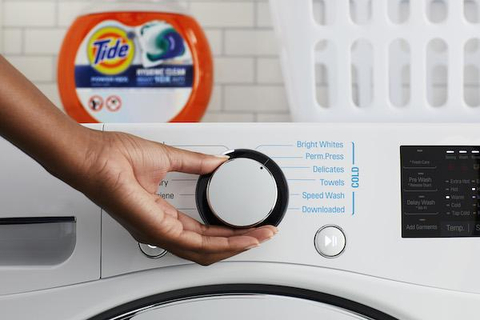CINCINNATI
,
April 26, 2023
(press release)
–
Using Washing Laundry on Cold as a Model, Tide and WWF Explore How to Advance Eco-Habits with Consumers Tide and World Wildlife Fund (WWF) have joined forces to advance the science of eco-behavior change via a new research project – undertaken as part of an ongoing collaborative effort to make washing laundry in cold water the next broadly adopted eco-habit as an important step to reduce greenhouse gas emissions. Tide and WWF believe the insights gathered from their work together on laundry are applicable for all brands seeking to partner with consumers to create positive environmental impact. Their goal is to educate people and establish washing laundry in cold water as the accepted social norm. Washing on cold saves up to 90% of energy in every wash cycle, making it an impactful eco-habit. (Photo: Business Wire) Tide and WWF engaged behavioral science consultancy, Behavioral Insights Team (BIT), to undertake a comprehensive review of existing published research and case studies on sustainable habits, including relevant consumer tests from P&G and best practices in climate change impact from WWF. As brands and organizations increasingly seek to unlock habit change to enable widescale positive environmental benefits, the findings from the Tide and WWF project identified the importance of applying behavioral frameworks and systems thinking, such as: - Enabling new consumer habits by creating the capability to act either physically or psychologically, the opportunity to act via cues or feelings of social acceptance, and the motivation to act through alignment with intrinsic values or delivery of extrinsic rewards; and - Introducing interventions that are ideally a combination of easy (requires minimal effort), attractive (offers worthwhile incentives), social (makes one feel part of a group) and timely (uses relevant moments and offers a clear timeline for benefits). “For brands like Tide and many others, consumer use often makes up a significant portion of a product’s carbon footprint,” said Marty Spitzer, senior director of climate and renewable energy, WWF. “We’ve seen how small actions can add up to big impact, especially when addressing the use phase. Sharing these research findings and related cold water case study, will provide useful insights and guidance for all brands and consumers taking on the behavior change journey.” “When Tide set a goal for 3 out of 4 washes to be done on cold by 2030, we knew we’d need partners to help us drive the change,” said Todd Cline, Senior Director of Sustainability, North America Fabric Care, Procter & Gamble. “Within the first year of setting our cold water ambition we advanced a quarter of the way toward our goal – a promising signal that consumers were interested in making this shift. Now, we’ve used the proven frameworks that emerged from our work with WWF and BIT to inform all our #TurnToCold wash efforts across the business and to identify several key levers we’ll aim to pull at once to move consumers further into action.” Through the program, Tide developed an “ecosystem” to advance the habit of washing laundry on cold. The map focuses on increasing enablers and reducing barriers, such as encouraging cold as the default setting on washing machines, introducing disruptions at the point of laundry and helping make cold water washing a social norm through continued brand marketing and communications campaigns. Washing in cold saves up to 90% of the energy in every wash cycle1 and can save Americans up to $150 a year2. Tide estimates that a decade of Americans washing the majority (3 in 4) of their loads in cold would save enough electricity to power all of New York City and San Francisco for over a year3. That’s the equivalent of 27 million metric tons (MT) of GHG emissions4 or nearly ten times that of P&G’s global yearly operations.5 As one of America’s most trusted laundry detergents, Tide has helped lead the charge to switch to cold water washing for more than 20 years with breakthrough innovations like enzymes specifically optimized for performance in lower wash temperatures. Efforts to drive cold water adoption were advanced by the announcement of Tide’s 2030 Ambition, a set of broad-reaching sustainability commitments as part of Tide’s ongoing journey to decarbonize laundry, including a goal to cut GHG emissions by half in Tide’s manufacturing plants by 2030. For more information on cold water washing and Tide’s collaborative journey to make cold wash the next broadly adopted eco-habit, please visit Tide.com. For the full report, please see www.worldwildlife.org/publications/encouraging-us-households-to-wash-laundry-in-cold-water. About Procter & Gamble P&G serves consumers around the world with one of the strongest portfolios of trusted, quality, leadership brands, including Always®, Ambi Pur®, Ariel®, Bounty®, Charmin®, Crest®, Dawn®, Downy®, Fairy®, Febreze®, Gain®, Gillette®, Head & Shoulders®, Lenor®, Olay®, Oral-B®, Pampers®, Pantene®, SK-II®, Tide®, Vicks®, and Whisper®. The P&G community includes operations in approximately 70 countries worldwide. Please visit http://www.pg.com for the latest news and information about P&G and its brands. For other P&G news, visit us at www.pg.com/news. 1 On average, when switching from hot to cold water 2 In non-HE washer, 8 loads/wk from hot to cold, avg. electricity rate (13.3c/kWh) 3 According to reported city-wide annual electricity usage by New York Building Congress and the California Energy Commission 4 Over the decade, 2020-2030 5 As outlined in P&G’s Climate Action Transition Plan Chloe Kivestu Bilgehan UyarErol
Chloe.kivestu@ketchum.com
uyarerol.b@pg.com
* All content is copyrighted by Industry Intelligence, or the original respective author or source. You may not recirculate, redistrubte or publish the analysis and presentation included in the service without Industry Intelligence's prior written consent. Please review our terms of use.




